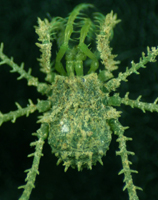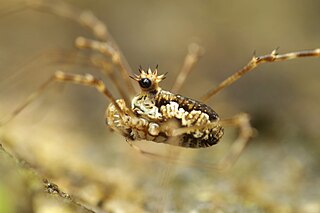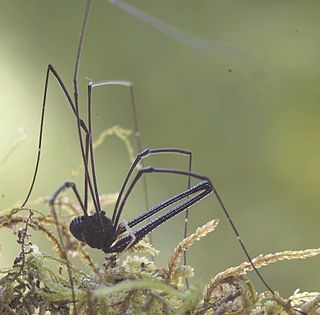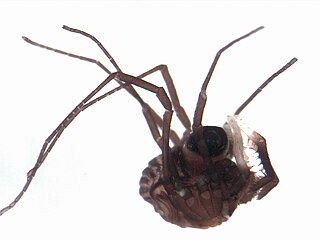Related Research Articles

The Opiliones are an order of arachnids colloquially known as harvestmen, harvesters, harvest spiders, or daddy longlegs. As of April 2017, over 6,650 species of harvestmen have been discovered worldwide, although the total number of extant species may exceed 10,000. The order Opiliones includes five suborders: Cyphophthalmi, Eupnoi, Dyspnoi, Laniatores, and Tetrophthalmi, which were named in 2014.

Laniatores is the largest suborder of the arachnid order Opiliones with over 4,000 described species worldwide. The majority of the species are highly dependent on humid environments and usually correlated with tropical and temperate forest habitats.

The opisthosoma is the posterior part of the body in some arthropods, behind the prosoma (cephalothorax). It is a distinctive feature of the subphylum Chelicerata. Although it is similar in most respects to an abdomen, the opisthosoma is differentiated by its inclusion of the respiratory organs and the heart.

Cosmetidae is a family of harvestmen in the suborder Laniatores. With over 700 species, it is one of the largest families in Opiliones. They are distributed from Argentina to the southern USA with the highest diversity in northern South America, Central America and Mexico. This Nearctic-Neotropical family comprises Opiliones with elaborate white/yellow/green/orange/red stripes and spots on the dorsal scutum and peculiar pedipalps strongly compressed and applied on the chelicerae.

The Eupnoi are a suborder of harvestmen, with more than 200 genera, and about 1,700 described species.

Megabunus is a genus of harvestmen with six known recent species. All occur in Europe, mostly in the vicinity of the Alps.

Megabunus diadema is a species of harvestman distributed in Western Europe, where it has been found in Iceland, Faroe Islands, Western Norway, Great Britain, Western France, Belgium and Northern Spain.

The Neopilionidae are a family of harvestmen.

Caddidae is a family of harvestmen arachnids with 15 known species, the only family of the Eupnoi superfamily Caddoidea.

An ozopore is the opening of a defensive gland present in some arthropods, notably in millipedes of the order Polydesmida and in harvestmen, the eight-legged arachnids also known as "daddy long-legs". The glands themselves are known as ozadenes, also called "scent glands", "repugnatorial glands", "odoriferous glands" or "stink glands" by various authors. The name is derived from Ancient Greek ozo "smell" and Latin porus "pore, small opening".
Eotrogulus is an extinct genus of harvestmen known from the Carboniferous fossil record. The genus is the only member of the family Eotrogulidae and contains one species Eotrogulus fayoli. Eotrogulus was found in the Coal Measures of Commentry in northern France, together with Nemastomoides elaveris. Eotrogulus was previously thought to be a trigonotarbid.
Nemastomoides is an extinct genus of harvestmen known from the Carboniferous fossil record. The genus is the only member of the family Nemastomoididae and contains three described species. Nemastomoides elaveris was found in the Coal Measures of Commentry in northern France, together with Eotrogulus fayoli.

Assamiidae are a family of harvestmen with more than 400 described species. It is the third most diverse family of the suborder Laniatores.
The Stygnidae are a family of neotropical harvestmen within the suborder Laniatores.
Agoristenidae are a neotropical harvestman family of the Suborder Laniatores, in the superfamily Gonyleptoidea.

The Cranaidae are a family of neotropical harvestmen within the suborder Laniatores.
The Icaleptidae are a small family of neotropical harvestmen within the suborder Laniatores. Although only two species have been described, many more are probably to be discovered.
The Fissiphalliidae are a small neotropical family of harvestmen within the suborder Laniatores.
The Synthetonychiidae are a small family of harvestman with a handful of species in a single genus. They are endemic to New Zealand.
Stomotheca is the term applied to the feeding apparatus in front of the mouth of harvestmen, and sometimes the related scorpions. Usually it consists of the epistome (labrum), two pairs of coxapophyses and often a labium.
References
- Pinto-da-Rocha, R., Machado, G. & Giribet, G. (eds.) (2007): Harvestmen - The Biology of Opiliones. Harvard University Press ISBN 0-674-02343-9